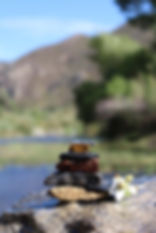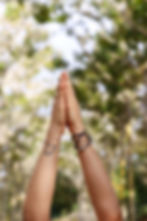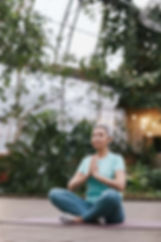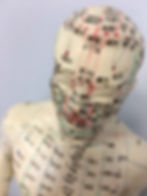Yin Yoga & Chinese Medicine: Inspiration for class themes (Pt. 3)
- Dr. Karina Smith
- Nov 7, 2021
- 8 min read
Updated: May 6, 2023
This article is the last in a series of articles I have been writing about Yin Yoga and Chinese Medicine. You can find Part 1 here and Part 2 here.
In this final instalment of the series, I would love to share some of the ways I have explored the themes and concepts of Chinese Medicine in my classes in a way that has felt more open-ended, interpretive and human centered. This has helped get me around some of the pitfalls I mentioned in Part 1.
Your scope of creativity is limitless when teaching Yin Yoga.
While there may only be a handful of postures to choose from, the way you frame a class can make it seem entirely new and fresh (even if the postures were delivered in the same sequence as the last class that you taught).
When I did my training with Bernie Clark, he shared that he would often teach a class that was pretty much identical in sequence every week, but he would give it an entirely new conceptual framing, which meant most of the time the students did not even notice the sequence was the same because there was a new intention to explore (I'm sure you have done something similar with your classes!)

Over time, I personally found that the things that were most relatable for people coming to class were the inner state of their minds and hearts.
I could feel confident knowing that I could speak about stress, anxiety, grief, feeling out of balance, and needing down time to re-centre, and know that most (if not all) of the people in the room would feel a resonance to the words on offer.
To make sure I did not accidentally wander too far into the "life coach" lane, I would always think of ways in which the words/concepts/themes all had a symbolic or literal connection to the breath or the body.
Because Yin Yoga is such a deeply felt practice, I really like the notion of being offered an idea that can be both thought provoking whilst also have an avenue for embodiment.
Using concepts in your sequences
If you use concepts for inspiration, you will actually give yourself lots of freedom and flexibility instead of tight rigid structures that might make you feel to restricted in each class.
Integrating the seasons into your concepts can be lovely.
It helps remind people about their interconnectedness with nature; that we ebb and flow with the natural world and can explore more balanced health when we go with the grain of the seasons rather than resist them.

An example of a "concept" for the liver might be about softening your expectations of outcomes or the need to control outcomes, as opposed to just talking about the functions in the body that the liver is responsible for during the class.
As a side note, I don't think you have to strictly offer postures that explore the Liver meridian if you wanted to speak about some "liver" concepts in spring, unless you feel that you need that kind of structure.
You won't be getting it wrong.
I think it is a better idea to offer a well rounded practice that explores many places of the body as Target Areas rather than just the front of the hips as an example.
Class Themes On Offer
By no means am I claiming to be the Chinese Medicine police when it comes to referencing this medicine in Yin Yoga classes. There is so much to learn as a community and I am always open to new ideas that other people are doing in their classes.
These are simply some offerings of ways in which I have explored the organs as inspirational concepts for my classes over the years.
Feel free to take what resonates with you, and leave behind that which doesn't. I won't be reeling off the exhaustive list of functions associated with each organ pair.
Rather than writing out particular postures and sequences, here I will simply offer some of the many ways that I have woven ideas together and contextualised them with the body/breath/mind.
Liver
"Softening our need to control the outcome"
Using the exhalation to practice feeling the sensation of softening.
Noticing if you had particular expectations of your body in class today as to what you "should" be feeling, or how "deep" you were able to move into postures.
Paying attention to sensations you can feel in the moment rather than projecting the mind forward onto what you anticipate is coming.
"Moving things that feel stuck"
Spring as a time to come out of hibernation and begin to move and thaw out
When Liver qi stagnates it can create feelings of stickiness and tightness. Where if anywhere are you feeling sensations like that in your body today? Maybe checking at the end of the practice to see if those sensations have changed.
Exploring ways in which you can expand into different areas of the body with mindful inhalations.
Encouraging sighing on the exhale as a way to help the body clear out deep held tension.
Offering loving kindness meditations as an antidote to anger and frustration.
Gallbladder
"Cultivating courage"
Noticing when you may have had moments of timidity lately, and if you can get a sense of how that feels in the body.
Offering a lots of options in the practice to encourage autonomy and confidence in making clear choices for oneself.
"The upward and outward movement of Spring"
Creating sequences that first explore the feet and lower body and eventually the upper body and head as a way of mimicking the upward and outward movement of Qi during Spring.
Lungs
"What inspires you / Getting in touch with our inspiration"
Opening the practice with an invitation to take your mind to a moment/song/event/other that has inspired you or does inspire you and notice how that feels in the body. Inviting that feeling to travel with you during the practice.
Every time we breathe in we are creating part of our daily Qi.
Including time for pranayama in the class
The lungs are the first internal organ that receives the world. How do you take this in? What kind of choices do you make in terms of what you "breathe in"?
Large Intestine
"In order to receive the new, we must let go of the old" / "Autumn as a mentor for healthy shedding"
Each exhalation is necessary in order for us to breathe in life giving oxygen.
Every time you breathe out you are practicing the art of letting go of what no longer serves a purpose within you.
Using the practice today as a form of full body/energetic cleanse.
"The descending movement of Qi"
Exploring the feeling of a heavy body during the asanas.
The Qi of the Large Intestine moves downward like gravity. How can you explore your relationship with gravity in the practice where it is able to move down through you, rather than you resisting gravity with your muscular activation.
Heart

"Getting in touch with your inner joy"
Opening the practice with an invitation to take your mind to a moment/song/event/other that has made you feel a sense of quiet no strings attached joy, and notice how that feels in the body. Inviting that feeling to travel with you during the practice.
"Exploring the fire element"
What lights you up?
How has the fire element created massive transformation for you?
The fire of "Yang" in the body is needed for every single transformation. Without it we would be cold, still and inert.
Stomach
"Noticing the sense of craving as it arises" / Observing the things we "crave" or "avoid"
What are you drawn to? Do you crave to stay longer in a shape? Or do you desire to come out of poses early and/or stay in the rebound for much longer?
Exploring the postures in order to find a "satisfying" level of intensity.
"You are enough"
Encouraging students to appreciate their "wholeness" and rewrite internal stories about themselves that focus on "lack" or "not being enough"
Inviting the whole self to be included in the practice. Can you invite all parts of yourself to come home and be present during the practice.
Spleen
"Nourishing the earth element of the body"
Attention on the rising and falling of the belly as you breathe. Breathing into the "earth centre" of the body.
What are you digesting? Ideas/information/food/media and is this helping or hindering the earth element in the body.
Including mindfulness techniques and ideas to help ground a mind that relentlessly ruminates.
Small Intestine
"Cultivating your inner knowing and discernment"
Trying out different props and options of shapes in the body to discover what "feels right for you"
Using the quiet and stillness of the practice to invite clarity to meet you where you have been unsure.

Kidneys
"Winter as the time of year to replenish your reserves"
Lots of reiteration of the importance of rest and slowness in the practice and also in life.
Without sufficient stores of Yin, the Yang will eventually run out of its fuel source and we "burn out."
Continually reinforcing a sense of permission to rest.
The rest of Winter helps to create the reserves needed in Spring when we begin to rise up.
Noticing moments in the body where it feels like rest and relaxation is occurring.
Noticing the places where the body is making direct contact with surfaces beneath them and using the exhalation as a place to let the body sink deeper into those surfaces.
Bladder
"Embodying the quality of water in the way you move in and out of the postures"
The inhales and exhales mimicking high and low tides within the body
The movement of the spine and bones floating in the water of the body
Inviting thoughts and sounds to passively float to you, rather than extending you mind away from the moment to reach them.
"Noticing the surface layers of the body, and then travelling into the deeper layers of the body"
Guiding attention toward feeling different layers in the practice; skin, muscles, organs, bones.
Staring with postures that explore the back of the body (yang) and then exploring postures at the front of the body (yin).
Pericardium
"Using the practice to explore the concept of "boundaries"
Starting the practice with a guided visualisation that allows each person to craft a boundary around their body according to what they need on that day; it might be made from light or bubbles, netting, canvas, wood, brick etc. It might be very close to their body or far away.
Using the feeling of the breath throughout the class to make space internally within the body; around the heart/mind/wherever space might be needed.
"Offering loving kindness meditations as an antidote to anger and frustration"
Do you feel the negative spaces around the body while in the shapes? ""
San Jiao
"Flowing without resistance"
Where have you been feeling like you are resisting the movements of flow in your world lately?
Starting the practice with a body scanning exercise to notice where there might be places in the body that are feeling restrictions/tension or even pain, and also where there are places that feel more relaxed and easeful.
Offering a lot of verbal guidance to use the feeling on inhaling and exhaling to encourage the continuous feeling of "flow" moving in and out of the body.
I hope that these ideas have helped to spark some more of your own creativity and inspiration for your yin yoga classes. Sometimes being a little more abstract can give us and our students the space to find our own way through an intention on offer (did I mention I have a background in interpretive dance?).
And remember, you don't have to draw your inspiration from these Chinese Medicine concepts at all if it down not resonate with you!
Any practice where we are offering people are place for them to rest, be mindful and quiet is medicine in itself.
Karina x

Ready to go further on your exploration of Yin Yoga and Chinese Medicine?
Join Karina for her online Yin Yoga & TCM course with over 4+ hours of learning, a dedicated educational portal and over 20 individual lessons.
Enrol for AUD$149 and receive unlimited access and for a limited time use promo code SAVE10 to get 10% off.
